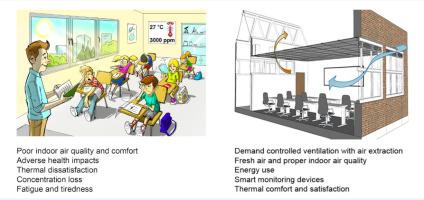Energy and Buildings ( IF 6.6 ) Pub Date : 2021-02-19 , DOI: 10.1016/j.enbuild.2021.110838 Shamila Haddad , Afroditi Synnefa , Miguel Ángel Padilla Marcos , Riccardo Paolini , Steven Delrue , Deo Prasad , Mattheos Santamouris

|
Indoor thermal comfort and air quality in school classrooms are of interest worldwide, primarily because of their potential impacts on students’ health, learning performance and productivity. Further, increasing concerns with changing climate and building energy efficiency highlight the importance of ventilation and comfort in educational settings. The existing literature on indoor air quality (IAQ), ventilation, and thermal comfort in classrooms in subtropical regions of Australia is sparse. Here, we present the results of a field study conducted in secondary school classrooms in Sydney during the school year in 2018 and 2019. We collected data with subjective surveys through questionnaires and with field measurements related to IAQ the thermal comfort in two adjacent similar classrooms. The infiltration and ventilation rates were measured during the non-occupied period using the concentration decay method. We analysed the performance of a cloud-connected demand-controlled mechanical extract ventilation system (DCV), which was installed in one of the two surveyed classrooms during mid-season. Before application of the DCV, CO2 levels were similar in both classrooms with a maximum concentration of approximately 2418 ppm during cold season. The DCV reduced the peak CO2 concentration to 1335 ppm, while CO2 raised to 2981 ppm in the classrooms without DCV during mid-season. Further, Volatile Organic Compounds (VOCs) analysed from air samples show improved air quality in the classroom with DCV. Our results highlight the impact of both indoor temperature and CO2 concentration on students’ feeling of fatigue. Students showed adaptability to indoor temperature change. A period of one week is needed for students’ adaptation to a step change in the mean outdoor temperature. Understanding classroom indoor air quality and thermal environment, as well as students’ perceived comfort, is vital to develop child-based design guidelines for schools.
中文翻译:

在澳大利亚学校教室中,按需控制的通风系统具有改善室内空气质量和热状况的潜力
全球学校教室中的室内热舒适性和空气质量受到关注,这主要是因为它们可能对学生的健康,学习成绩和生产力产生影响。此外,人们对气候变化和建筑节能的关注日益增加,这凸显了教育环境中通风和舒适的重要性。澳大利亚亚热带地区的教室中有关室内空气质量(IAQ),通风和热舒适度的现有文献很少。在这里,我们介绍了在2018和2019学年期间在悉尼的中学教室中进行的一项现场研究的结果。我们通过问卷进行了主观调查,并通过与IAQ相关的实地测量收集了两个相邻相似教室的热舒适性的数据。使用浓度衰减法在非占用期间测量渗透率和通风率。我们分析了连接云的按需控制的机械排风系统(DCV)的性能,该系统在季节中期安装在两个接受调查的教室之一中。施加DCV之前,CO2个水平与在寒冷季节约2418 ppm的最大浓度两者教室相似。DCV将高峰期的CO 2浓度降低至1335 ppm,而在季中无DCV的教室中,CO 2升高至2981 ppm。此外,从空气样本中分析出的挥发性有机化合物(VOC)显示,使用DCV可以改善教室的空气质量。我们的结果突出了室内温度和CO 2的影响专注于学生的疲劳感。学生表现出对室内温度变化的适应能力。学生需要一个星期的时间来适应室外平均温度的逐步变化。了解教室的室内空气质量和热环境以及学生的感知舒适度,对于制定针对儿童的学校设计准则至关重要。











































 京公网安备 11010802027423号
京公网安备 11010802027423号